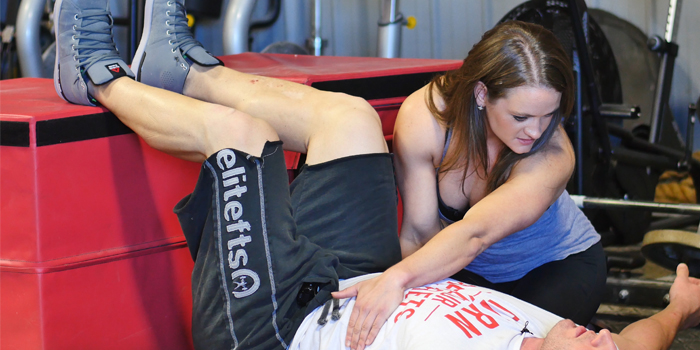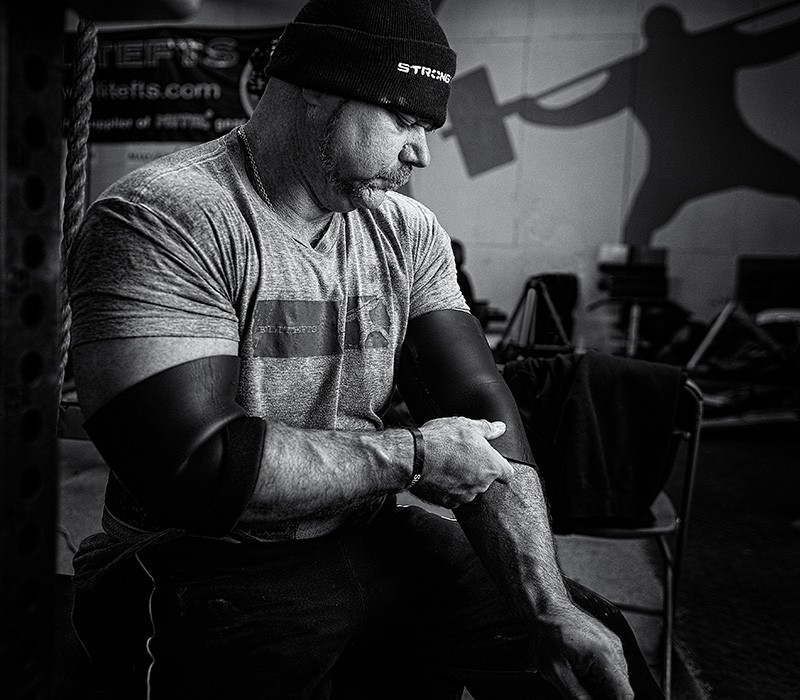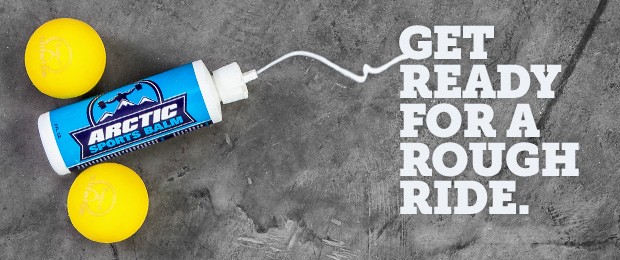
How is Dave Tate still doing Dave Tate things, lifting like he is? Why didn’t rehab or PT work for me but works for the guy who has compiled injury after injury?
Go check out his training log. “Most” people with joint replacements are not going to dream of putting a bar on their back again. It's safe to say that Dave—who he is as a person—inspires every single person that ever comes to this site on a physical, emotional, and mental level.
And safe to say that with his self-proclaimed “mashed-up meathead” title, he owns the fact that in order to do some of the things that inspire us, to go through some of the growth processes that he has, he hasn’t necessarily always done the smartest things to his body. We also know he’s got great communication with some of the best experts around, so it’d be easy to say, “Well, he’s in the best hands. Of course, he’s going to be okay.”
It’s not that simple. Take a reckless, brazen athlete to the same doctor and they will not get the same input. Every medical professional is gauging how much slack on the leash they can give you without negative effects because everyone’s threshold is a little different. What’s Dave’s? And why? You have a LOT you can learn from him to actually use the people around you as resources.
RECENT: 10 Big Lessons 2016 Taught Me
A little perspective: Dave called me last week to talk about his recovery and a few recent complications. He wanted to touch base regarding how he can modify his training. If you’re like me, you kind of assume Dave knows just about everything. If he’s asking me questions, I’m pulling out all the back pocket aces and trump cards I can for him, not because I feel pressured to, but because all the interaction I’ve had with Dave, especially regarding his rehab and training programs, has given me the message that "Yes, I can trust him."
As a strength athlete, we sort of laugh at the idea that, “Yeah, my PT and I don’t see eye-to-eye on things. They’ll only take me so far, then they know I’m going to go do something stupid.” And we’ve owned it. What that has done is create a working relationship based on distrust on both ends.
Here’s the thing: they laugh at you, too.
Oh my gracious, I absolutely hate that. Let me help you learn why Dave actually gets what he needs to out of those he consults with. As an athlete, I’m going to take what a PT tells me with a grain of salt because I’m sure as hell not giving up my training. I can handle a little pain here and there and have come to terms with some aches and pains because we’re doing things we aren’t necessarily meant to do.
As a PT, my job, my profession, my reputation (which is everything in a market becoming increasingly saturated with under-qualified, prideful, and undereducated voices), and ultimately my ass is on the line. There are a lot of things we can help with, but what happens if the client takes things too far, applies them poorly, and is then put under load? Oh hell no. More information may just be enabling someone to think they know more than enough and can perform a task beyond their neuromuscular system’s ability, and then it comes back to bite us. I’m probably not incredibly motivated to pull out the big guns until you have shown me I can trust you with them.
I made suggestions to Dave I would not make to almost anyone else because I trust him. If you’re trying to stay healthy, or you’re in meet prep, this could be the difference between performing and not. More than that, this could be the difference between you easily getting in and out of the chair you’re sitting in right now, and taking a solid 20 seconds for your joints figure out where they are in space before you're able to start moving.
Dave gets the back pocket tricks from the experts around him because he has worked intentionally to build a two-way communication, a partnership, built on mutual trust. This is why Dave can still do Dave things.
Dave and I talked last week, but this conversation started last April, about the same time I was working with Casey. In the context of his movement and pain, he had a few key ideas already ironed out:
1. He told me his training goals, specifically. Depending on where you are in your training, that may mean something as simple as, “Be able to increase frequency without aggravating a chronic injury,” or it may be, “I’m six weeks out.” Either way, what that cultivates is openness and honesty. That may seem so stupidly simple and make you say, “Duh”, but this is where dialogue begins. It’s a little vulnerability on your end to be completely honest about both your goals and whether or not you think your body may actually get there, but appropriate vulnerability means honesty.
2. Any conversation you have, there’s a gut feel on whether or not someone is holding something back from you. That goes two ways. Part of why Dave gets forthright information is because he gives his team forthright information. Trust begets trust. There are things Dave told me about his training that he could have held back thinking I may tell him not to do them. He inherently valued my input, even if it meant hearing no, which means I know he values what I have to say. As a result, I’m a lot more likely to say, “Let's work with that,” rather than play it a little more conservative.
RELATED: On the Mend... Another Hip Replacement
3. Once he told me where he wanted to go, he told me how he was planning on getting there. “Here’s my training setup. What do you think about exercise selection, frequency, volume, and overall intensity?” Again, all in the context of injury and trying to train, this told me where he is and that he’s at least thinking about these things; he opens the dialogue to talk about the variables that may make or break his training. The fact that he brings these ideas up means his medical team is a lot more likely to actually speak to them and give more information and input (e.g., the things that help Dave to Dave things) in part because of the dialogue that snowballs from there and in part because it demonstrates rational thought. Most people, when they talk to me, have some variation of, “I took things too far and did something really stupid, against someone's advice.”
4. He actually modified his programming and stuck with it. Hello, do I really need to say anything about this?
Dave: “Hey, Dani, is it ok for me to do this thing?" (Valued opinion, cultivated honesty, vulnerability in the idea that I could very well tell him no way and good luck.)
Me: “For anyone else who doesn’t pay attention to their body, no. They’ll take it way too far. For you, probably, but I think this may be a better idea and here’s why.” (His vulnerability let me loosen the leash, in a very forthright way. He got information and learned, rather than simply hearing yes or no. This is what you want to get out of working with anyone, always. Again, this is part of why Dave can still do Dave things.)
Dave: “Got it, I’ll do that. What kind of weight, how many reps, how many sets? How many days a week should I do that?”
Catch that. Not just, “Sure, I’ll do it,” but the follow-up questions. Without a shadow of a doubt, at that point, I knew he was actually going to implement what we’d talked about. On follow up, he did, which has continued to grow trust and allowed me to make suggestions I would be cautious to make with many others.
5. Dave thinks about more than just digging out of a hole; he prioritizes assessment. He’s worked with a number of clinicians over the years not just for treatment, but because he valued long-term assessment of what was happening in his body. Let's look at lifters today.
- Knee Sleeves: $80
- Wrist Wraps: $30
- Pre-Workout: $30
- Random “food and specific exercise/iron analogy” Shirt: $25
- Online Coaching (In the form of a spreadsheet): $25/Week, $300 for a 12-week cycle
Option 1: Movement Assessment (To make sure you’ re not doing something dumb for your body based on personal mechanics): $0. "It’s too expensive.” Yeah, alright, take option two below. THEN complain to me once you dig into a hole you can’t get out of because you never actually valued what a professional may have to say.
Option 2: PT Copays (If you have good insurance): $40, twice per week. For multiple weeks, that's a lot of money. Most people at that point are not likely to follow through. But the sick thing is, they do it all again next training cycle and end up with compounded injuries. Dave learned that the hard way, and in the last 10 years or so, has learned to stop doing it. He spent the last decade seeking out a specific treatment provider not because of the treatment itself but because of what the assessment from the treatment told him and modified appropriately.
The biggest themes that emerge with why Dave actually gets the good information from his providers is because he puts himself out there and stimulates dialogue to learn. He wants to actually hear what we have to say. It’s not because of his reputation makes providers say, “Dave Tate’s in my office.” His reputation says, “I'm going to push the envelope because that’s what I did for decades.”
That’s akin to when you, as a powerlifter, tell your PT or doctor exactly how your body is going to cope: “Nah, I’ll do this. It’s alright, but help me dig out of this hole later.” Yeah, we’re certainly going to trust you then, genius. What Dave’s actions tell us is that he wants to dialogue, to learn, and to listen. His actions tell us that he realizes the value of what we have to say.












I'm a current DPT student and I'm interested in working with strength and fitness athletes when I graduate. How did you get started in your field and do you have any advice as to how I can get a jump start in the industry.
Thanks!
So we're left figuring out on our own, trying to avoid major injuries. Come back 2 years later, they're happy to tell us our improved stats are the max we could ever do.
Lather, rinse, repeat.